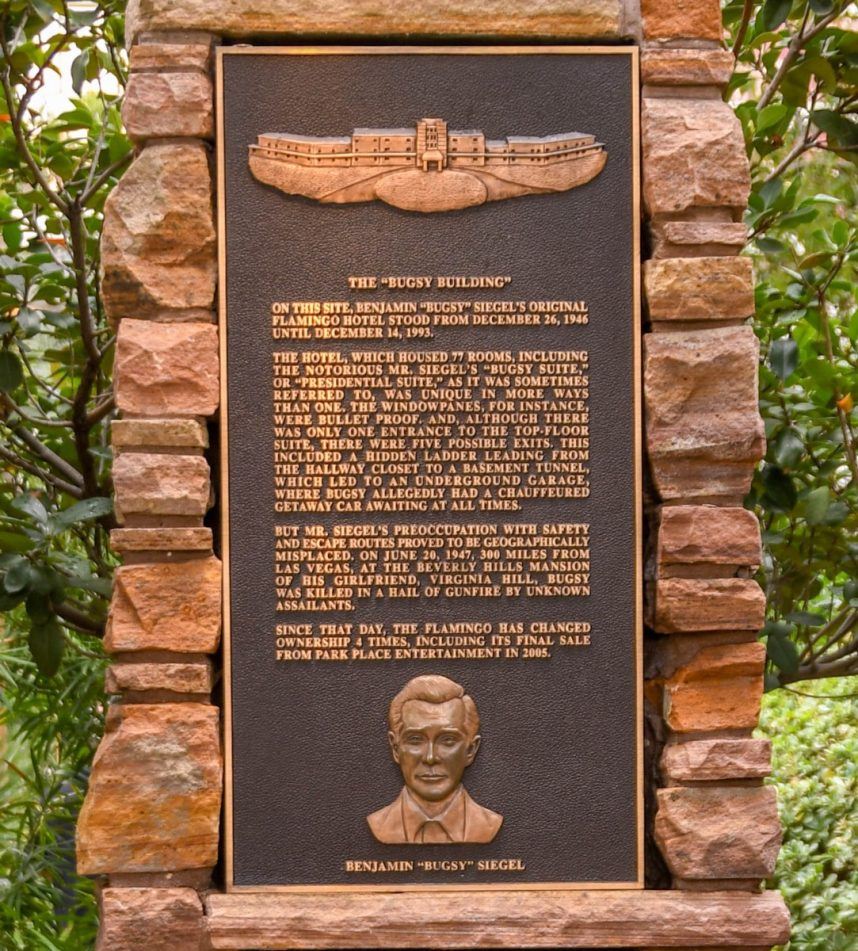The four-story building behind the swimming pool was not only the final structure associated with mobster Benjamin “Bugsy” Siegel to be demolished at the Flamingo Las Vegas, it was the one hiding the secret.
 The Oregon Building at the Flamingo is shown in the 1950s. Bugsy’s top-floor suite is circled in red. Inset: a Siegel mugshot from April 12, 1928. (Images: Getty)
The Oregon Building at the Flamingo is shown in the 1950s. Bugsy’s top-floor suite is circled in red. Inset: a Siegel mugshot from April 12, 1928. (Images: Getty)The Oregon Building was where Bugsy kept a suite overlooking the pool, Room 44000. We’d describe its fantastical details in our own words, but the plaque installed after its demolition does a perfect job…
“Although there was only one entrance to the top-floor suite, there were five possible exits,” it reads. “This included a hidden ladder leading from the hallway closet to a basement tunnel, which led to an underground garage, where Bugsy allegedly had a chauffeured getaway car awaiting at all times.”
So much for secrets. According to the plaque, Siegel’s place (aka the presidential suite) also had bulletproof windows.
As hindsight proved, such precautions weren’t so paranoid.
A Story Full of Bullet Holes
 This plaque, installed near the site of the former Oregon Building in late 1993 or early 1994, memorializes not only Siegel but a flat-out lie. (Image: Shutterstock)
This plaque, installed near the site of the former Oregon Building in late 1993 or early 1994, memorializes not only Siegel but a flat-out lie. (Image: Shutterstock)Here’s the problem … None of Siegel’s associates ever mentioned any escape tunnel at the Flamingo.
And while it could very well be that the thousands of people involved in building and maintaining the Oregon Building managed for 47 years to keep mum about its most famous notorious secret feature — even long after their employment ended — a search of the 970 million pages on Newspaper.com yields zero hits for the terms “Bugsy Siegel” and “tunnel” until a syndicated 1992 article by journalist Yardena Arar of the LA Daily News.
Oh wow, what a coincidence! The Warren Beatty movie “Bugsy” came out only a year earlier. You don’t think the Flamingo’s fifth owner, Hilton Hotels Corporation, could possibly have viewed the movie as an opportunity to promote Bugsy tourism by making this whole story up, do you?
On tours given of the grounds while the Oregon Building still stood, guests — who could dine on the $14.95 “Bugsy’s Speakeasy Special” dinner at the Flamingo’s Beef Barron restaurant — were “informed” about the suite and its many secrets.
Before the plaque went up in 1993 or 1994, some versions of the story featured two chauffeured getaway cars. Each was pointed in a different direction, giving the car containing Bugsy a 50/50 shot of escaping gunfire.
It almost feels like a wish-fulfillment fantasy. Siegel sure could have used a setup like this at the Beverly Hills home of his girlfriend, Virginia Hill, on the night of June 20, 1947. Or, as the plaque callously puts it: “Mr. Siegel’s preoccupation with safety and escape routes proved to be geographically misplaced.”
Myth Interpreted
 Bugsy Siegel is shown in 1940, during questioning by LA police about the gangland slaying of mob associate Harry “Big Greenie” Greenberg in Hollywood the previous year. Siegel was tried and acquitted. (Image: Bettmann Archive/Getty Images)
Bugsy Siegel is shown in 1940, during questioning by LA police about the gangland slaying of mob associate Harry “Big Greenie” Greenberg in Hollywood the previous year. Siegel was tried and acquitted. (Image: Bettmann Archive/Getty Images)Like many good myths, this one at least contains a grain of truth.
The Civilian Production Administration (CPA) — a short-lived federal agency tasked with regulating non-war-related building during the final phase of WWII and its immediate aftermath — originally approved plans for the Flamingo to be constructed, but only as a single building.
When the CPA observed three separate wings going up in 1946, it ordered construction halted.
Why the organization reversed its decision is open to fairly obvious speculation. But memoirs and secondary accounts say that Bugsy successfully managed to convince the organization that tunnels connecting the three hotel wings — constructed to allow the discreet movement of staff, VIP celebrities and supplies — qualified the Flamingo as a single structure.
The Oregon Building was a separate, unconnected structure used for staff housing and overflow lodging.
Tunnel Vision
Probably the most damning evidence against the story was the lack of any report from Hilton Hotels about trap doors or tunnels ever being located in the Oregon Building. A corporation that marketed a story like this would certainly have gone looking for evidence of it to press-release about.
But we’re supposed to believe that it cared enough about this story to pre-plan the installation of a plaque legitimizing it forever, yet couldn’t be bothered to conduct a thorough search of the suite anytime it wanted after purchasing the Flamingo in 1970.
Maybe previous remodels sealed up the trap door and/or tunnel.
OK, so why not unseal them, excavating and photographing their vestiges? Hell, make a TV documentary about the experience! We all would have watched it! If done immediately before demolition, Hilton Hotels wouldn’t have even had to pay a dime to restore the suite!
We can’t think of a better way to close this bust than by quoting the following line from “Bugsy,” spoken by Hill to Siegel…
“Dialogue is cheap in Hollywood, Ben.”
Look for “Vegas Myths Busted” every Monday on Casino.org. Click here to read previously busted Vegas myths. Got a suggestion for a Vegas myth that needs busting? Email corey@casino.org.
The post VEGAS MYTHS BUSTED: Bugsy Siegel’s Secret Flamingo Escape Tunnel appeared first on Casino.org.

 - Casino.org_ - www.casino.org.png) 10 hours ago
22
10 hours ago
22

















